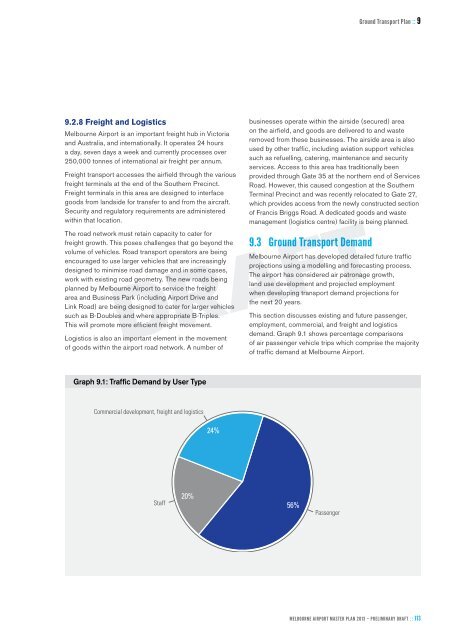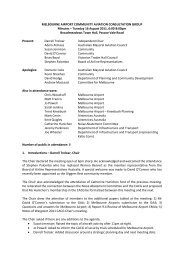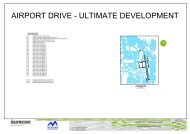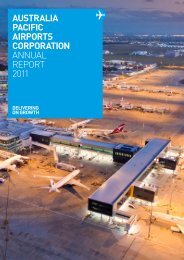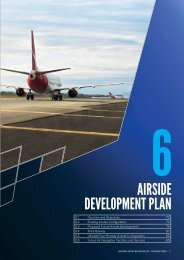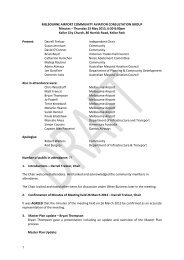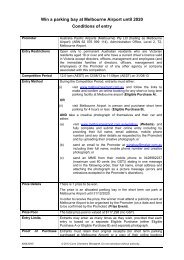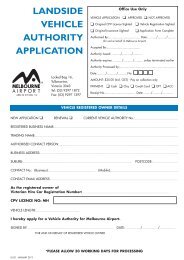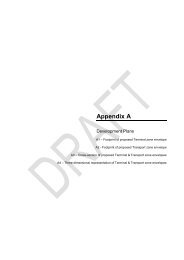Section 9 - Ground Transport Plan - Melbourne Airport
Section 9 - Ground Transport Plan - Melbourne Airport
Section 9 - Ground Transport Plan - Melbourne Airport
Create successful ePaper yourself
Turn your PDF publications into a flip-book with our unique Google optimized e-Paper software.
<strong>Ground</strong> <strong>Transport</strong> <strong>Plan</strong> :: 9<br />
9.2.8 Freight and Logistics<br />
<strong>Melbourne</strong> <strong>Airport</strong> is an important freight hub in Victoria<br />
and Australia, and internationally. It operates 24 hours<br />
a day, seven days a week and currently processes over<br />
250,000 tonnes of international air freight per annum.<br />
Freight transport accesses the airfield through the various<br />
freight terminals at the end of the Southern Precinct.<br />
Freight terminals in this area are designed to interface<br />
goods from landside for transfer to and from the aircraft.<br />
Security and regulatory requirements are administered<br />
within that location.<br />
The road network must retain capacity to cater for<br />
freight growth. This poses challenges that go beyond the<br />
volume of vehicles. Road transport operators are being<br />
encouraged to use larger vehicles that are increasingly<br />
designed to minimise road damage and in some cases,<br />
work with existing road geometry. The new roads being<br />
planned by <strong>Melbourne</strong> <strong>Airport</strong> to service the freight<br />
area and Business Park (including <strong>Airport</strong> Drive and<br />
Link Road) are being designed to cater for larger vehicles<br />
such as B-Doubles and where appropriate B-Triples.<br />
This will promote more efficient freight movement.<br />
Logistics is also an important element in the movement<br />
of goods within the airport road network. A number of<br />
businesses operate within the airside (secured) area<br />
on the airfield, and goods are delivered to and waste<br />
removed from these businesses. The airside area is also<br />
used by other traffic, including aviation support vehicles<br />
such as refuelling, catering, maintenance and security<br />
services. Access to this area has traditionally been<br />
provided through Gate 35 at the northern end of Services<br />
Road. However, this caused congestion at the Southern<br />
Terminal Precinct and was recently relocated to Gate 27,<br />
which provides access from the newly constructed section<br />
of Francis Briggs Road. A dedicated goods and waste<br />
management (logistics centre) facility is being planned.<br />
9.3 <strong>Ground</strong> <strong>Transport</strong> Demand<br />
<strong>Melbourne</strong> <strong>Airport</strong> has developed detailed future traffic<br />
projections using a modelling and forecasting process.<br />
The airport has considered air patronage growth,<br />
land use development and projected employment<br />
when developing transport demand projections for<br />
the next 20 years.<br />
DRAFT<br />
This section discusses existing and future passenger,<br />
employment, commercial, and freight and logistics<br />
demand. Graph 9.1 shows percentage comparisons<br />
of air passenger vehicle trips which comprise the majority<br />
of traffic demand at <strong>Melbourne</strong> <strong>Airport</strong>.<br />
Graph 9.1: Traffic Demand by User Type<br />
Commercial development, freight and logistics<br />
24%<br />
Staff<br />
20%<br />
56%<br />
Passenger<br />
MELBOURNE <strong>Airport</strong> Master plan 2013 – PRELIMINARY DRAFT : : 113


